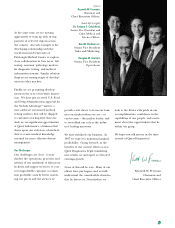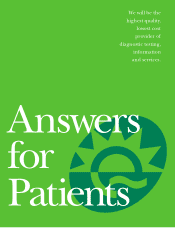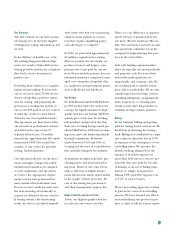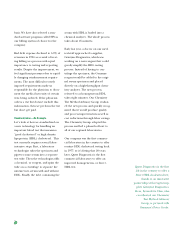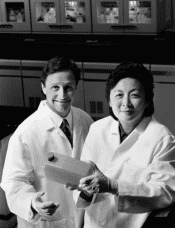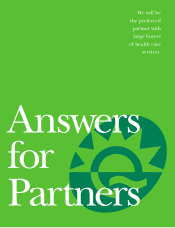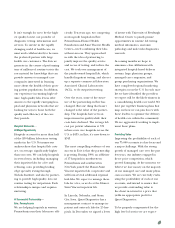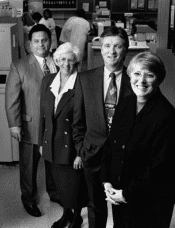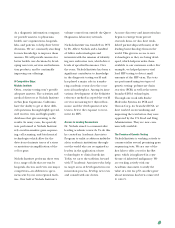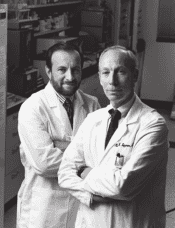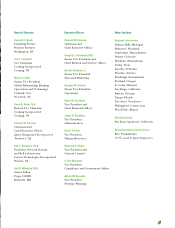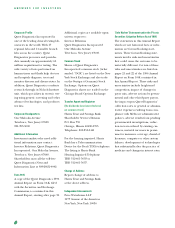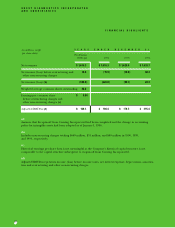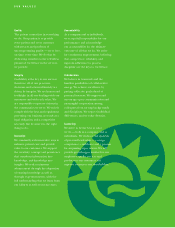Quest Diagnostics 1996 Annual Report Download - page 15
Download and view the complete annual report
Please find page 15 of the 1996 Quest Diagnostics annual report below. You can navigate through the pages in the report by either clicking on the pages listed below, or by using the keyword search tool below to find specific information within the annual report.
14
volume comes from outside the Quest
Diagnostics laboratory network.
Nichols Institute was founded in 1971
by Dr. Albert Nichols and a handful
of fellow endocrinologists and
internists with the mission of identify-
ing new endocrine tests, which detect
levels of specified hormones. Over
the years, Nichols Institute has been a
significant contributor to knowledge
in the diagnostic testing world and
has played a major role in transfer-
ring academic research to the com-
mercial marketplace. Among its inno-
vations: development of the definitive
reference method accepted the world
over for measuring free thyroid hor-
mone, and the development of new
tests to detect the response to treat-
ment for HIV.
Access to Leading Researchers
Dr. Nichols aimed to commercialize
leading academic research. To do this
he created an Academic Associates
Program to enlist as advisors individu-
als in academic institutions through-
out the world who are recognized as
leaders in the application of new
technologies to clinical medicine.
Today, we carry the tradition forward
with 57 Academic Associates who help
us target areas of development in our
innovation process, develop new tests
and consult with our clients.
As a diagnostic information company,
we provide answers to physicians,
health care organizations, hospitals,
labs, and patients to help drive better
decisions. We are constantly searching
for new knowledge to improve those
answers. We will provide answers for
better health care decisions by devel-
oping new tests, services and informa-
tion products, and by continually
improving our offerings.
A Competitive Edge:
Nichols Institute
Often, routine testing won’t provide
adequate answers. The scientists and
medical directors at Nichols Institute
in San Juan Capistrano, California
have the ability to get at these diffi-
cult questions through highly special-
ized esoteric tests and high quality
databases that give meaning to the
results. In many cases, the specialty
tests performed at Nichols Institute
rely on ultra-sensitive gene sequenc-
ing, cell scanning, and biochemical
technologies which allow for the
detection of minute traces of a virus
or mutation via amplification of the
cell or gene.
Nichols Institute performs these tests
for a range of labs that are run by
hospitals, doctors and even our major
competitors—in addition to speci-
mens sent by our own regional facili-
ties. Over half of Nichols Institute’s
As more discovery and innovation has
begun to emerge from private
research firms, we also have estab-
lished partnerships with many of the
leading biotechnology firms in the
world. This gives us access to new
technologies as they are being devel-
oped, which helps us make them
available to our customers earlier. For
example, we helped pioneer viral
load HIV testing to detect small
amounts of the HIV virus. The tests
are performed using two types of
genetic testing: polymerase chain
reaction (PCR) as well as the newer
branched DNA technologies.
Through our work with Roche
Molecular Systems for PCR and
Chiron Corp. for branched DNA, we
have worked on streamlining and
improving the tests before they were
approved by the U.S. Food and Drug
Administration. They are now com-
mercially available.
The Promise of Genetic Testing
Nichols Institute is working actively to
commercialize several promising gene
sequencing tests. We are one of the
first labs to offer a test for the Ret
gene, which is implicated in a syn-
drome of inherited malignancy. We
are working actively with our
Academic Associates to study the
value of a test for p53, another gene
whose mutation has been connected
to cancer.


